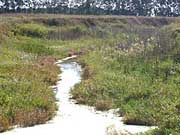| Polluted waters: A long and costly cleanup |
POLLUTION: Pollution of water, water pollution, or pollute the water means: (a) the discharge of any pollutant into any waters of the state, or the contamination of any waters of the state so as to create a nuisance or render such waters unclean, or noxious, or impure so as to be actually or potentially harmful or detrimental or injurious to public health, safety or welfare, to domestic, agricultural, commercial, industrial, recreational or other legitimate uses, or to livestock, animals, birds, fish or other aquatic life; or
(b) the alteration made or induced by human activity of the chemical, physical, biological, or radiological integrity of waters of the state. [Mn. Chapter 115.01; Subd. 5]
IMPAIRED WATER: A body of water that does not meet water quality standards and designated uses because of pollutant(s), pollution, or unknown causes of impairment.
The Clean Water Act requires states to publish, every two years, an updated list of impaired streams and lakes -- those that are not meeting their designated uses because of excess pollutants. The list, known as the 303(d) list, is based on violations of water quality standards and is organized by river basin.
THREATENED WATER BODY: A water body that currently meets water quality standards, but data indicate declining trends such that water quality standards will likely be exceeded in the next two years.
POINT SOURCE POLLUTION: Pollution from municipal and industrial facilities, usually entering a water body via discharge from a pipe or a discrete channel.
NONPOINT SOURCE POLLUTION: Pollution in runoff and seepage from land areas. The major origins of nonpoint source pollution include agricultural runoff; pesticide and fertilizer use; feedlot runoff; urban runoff from streets, yards, and construction sites; leachate from septic systems; runoff from forestry and mining activities; highway de-icing chemicals; and dredging and drainage activities. The MPCA says nonpoint source pollution accounts for 86 percent of the pollution in Minnesota rivers and lakes.
LOAD: The quantity of a pollutant that is or can be carried at one time, as compared to a concentration. A pollutant load is the quantity of a pollutant that a waterbody is carrying measured at a point in time.
TMDL, or TOTAL MAXIMUM DAILY LOAD: A "pollution budget," the maximum amount of a pollutant that a water body can receive and still meet water quality standards. Load allocation is the process of deciding who reduces pollution by how much.
TURBIDITY: Measures particles in the water, such as sediment and algae. Related to the depth sunlight can penetrate into the water. Higher turbidities reduce the penetration of sunlight in the water and can affect species of aquatic life that live in the water.
DISSOLVED OXYGEN: Oxygen is necessary to maintain a healthy ecosystem for fish and other aquatic life in a water body. Low levels of dissolved oxygen in a water body are a cause for concern. The problem is caused primarily by high phosphorus levels.
FECAL COLIFORM BACTERIA: Bacteria that originate in the intestinal tract of a mammal. Testing is used as an indicator that fecal matter is getting into the water body, and that other potentially harmful contaminants may also be entering the water body. The main sources of these bacteria are from animal and human waste, which gets into the water supply from farm runoff and leaky sewage systems.
REACH: A section of a river or stream that generally extends from one tributary to another, or sometimes from a tributary to a dam or other feature. A reach is typically less than 20 miles in length. Water quality assessments are made on individual river reaches using monitoring data for that reach, and other supporting information.
WATERSHED: The surrounding land area that drains into a lake, river or river system.
WETLANDS: A lowland area, such as a marsh or swamp, saturated with water. Wetlands are crucial wildlife habitat, and important for flood control and maintaining the health of surrounding ecosystems.
(Source: Minnesota Pollution Control Agency)




